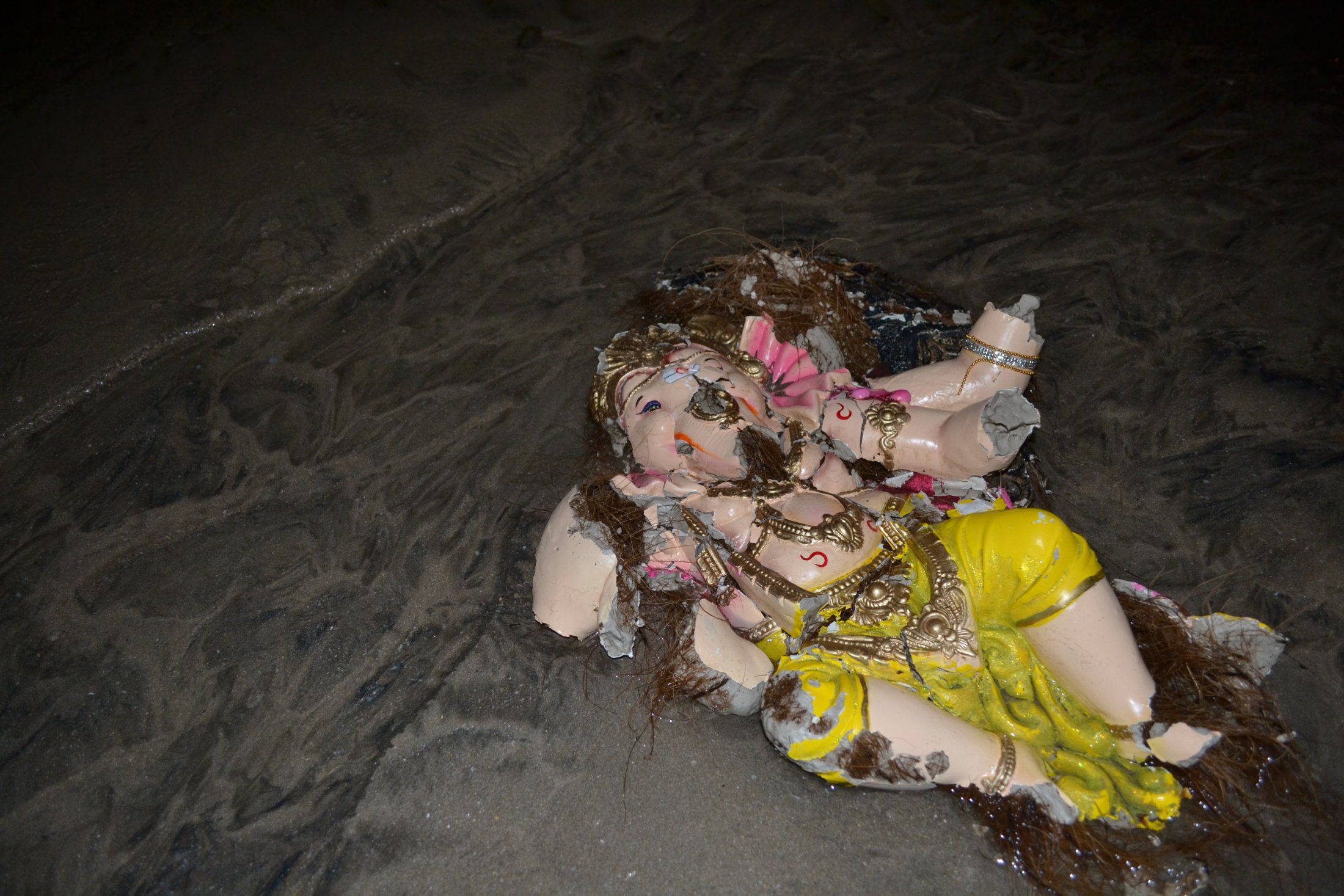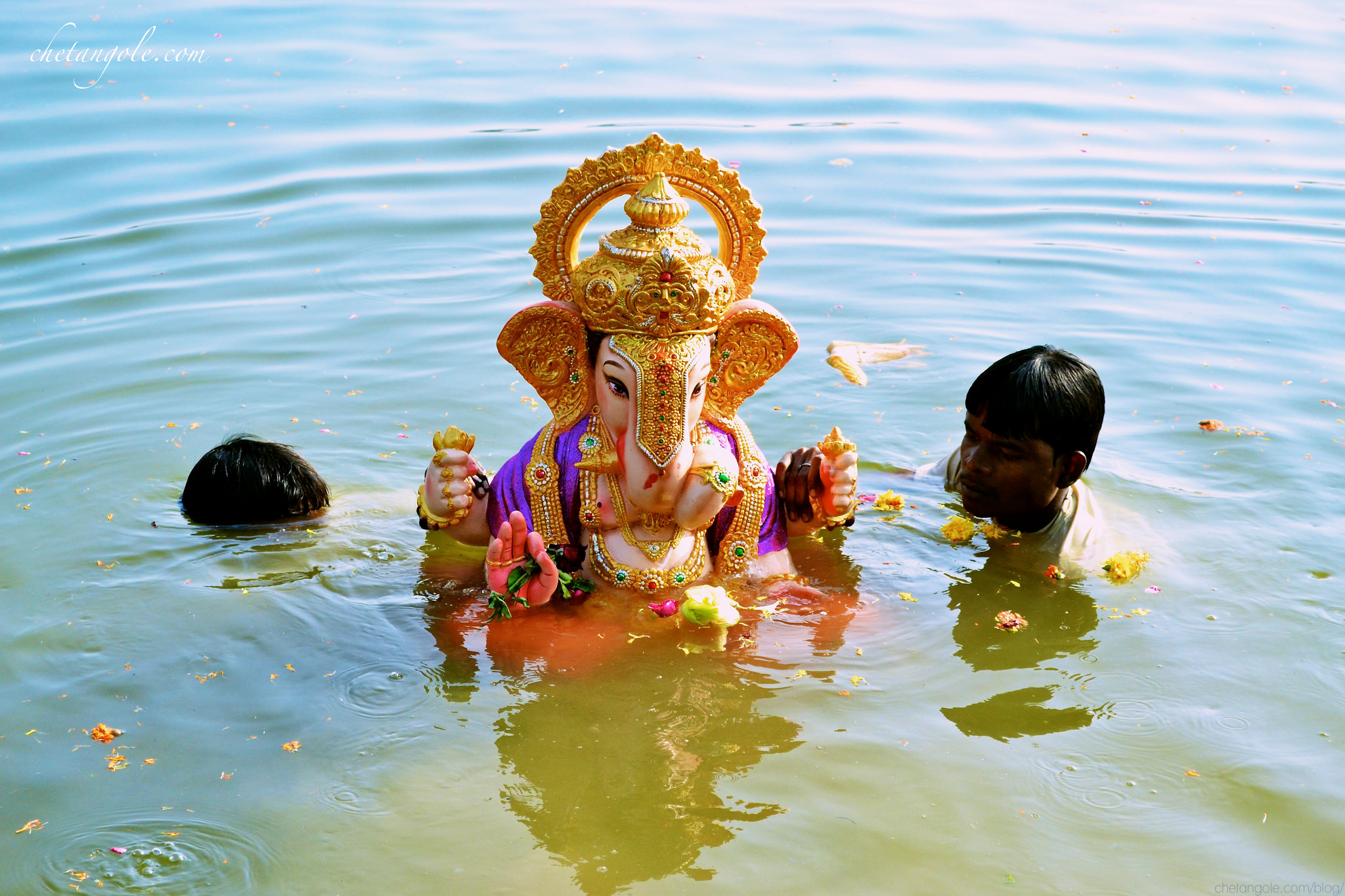Bang-bang go the bass drums. Snares crack like machine gun fire through the night. Echoes of chimes ring between each beat and a faint melody colors the whole huge cacophony a pale violet in the dwindling light of the urban evening. It’s Ganapati, the festival of the god who wears that very same name. Others know him by Ganesha, Vinayaka, Vighneshvara or Pillai. He is the lord of wisdom and intelligence, the remover of obstacles and the god of beginnings. As such people celebrate him 10 days a year in the most various ways of worship. They ornament his idol with flowers, fabrics and turmeric powder, “feed” it, bathe it, chant prayers, and practice prostration. On the last day, the idol, which is usually made of clay, is carried to a nearby well in an informal procession, and immerged into the water.
So much at least for the accounts of traditional and private family “puja” [= reverence/worship].
Nowadays, these small forms of puja seem to drown in a cataclysm of mass-celebrations around the time of Ganapati. Public statues, made of plastic and construction material, are erected all across the city and revered by a much bigger amount of people. Some neighborhoods pitch together to create a Ganapati site, other places are open to the public. Puja still uses the traditional elements, but so much more aside from that, as well: Performances are being held in front of the statues, music is being played – digitally or manually, people dance, sing, drink and lose themselves in celebrations around this 10-day-event.
As with all ritualistic traditions, it is hard to determine when exactly the private Ganapati puja emerged. The origin of the public version, however, can be dated back to 1893 pretty precisely. It was that year that nationalist Bal Gangadhar Tilak, a Brahman from Pune, succeeded in organizing the first public Ganapati festival. He most likely did so to partly undermine British regulations illegalizing public gatherings – and, some believe, to provide a sense of Hindu solidarity against powerful Muslim influence. Having realized independence, Indians continued to celebrate Ganapati to its full extend and the holiday still gained popularity, though mostly in Maharastra.
Today, the whole city of Mumbai experiences a breakdown of regular life when Ganapati comes around again. Traffic comes to an almost complete stop, the nights are filled with the sound of drums and music and around every corner there is another big statue of the elephant-faced god, placed on stages and shadowed by large tents and illuminated by bright halogenous headlights. People take days off work to celebrate with their families and friends and to transform the streets into an emergency-state-like environment. It is not like there is no daily life happening. On the contrary: It much rather feels like a very fairly evened out struggle between those who let loose of all day-to-day constraints and those who can’t or won’t.
There is actually much good to be said about Ganapati. It is an openly festive time presenting itself in an unconditionally positive character. An otherwise dull ambiance suddenly becomes an exciting, glowing and liminal experience. From an outer perspective those ten days even seem to deconstruct traditional roles and imageries and to let people enjoy themselves in an almost anarchic fashion, partying, enjoying themselves, and for once lowering culturally put on masks. That’s ten days of unruly high spirits and exceptional transgression of constructed ideas.
At last comes the so-called Ganapati Visarjan, the immersion of the very idol that has been revered and celebrated for the last couple of days. The statue, small or big is carried to a water source, in a procession similar to its traditional counterpart – and, at the same time, not like it at all: If you look close enough, you can still make out elements of traditional puja and you might even come across some prayers “chanted” every once in a while. However, thickly overlaying these rites, a modern construct of digitalization, plastic and extravagance is created, adapting Ganapati festival to its fanatically urban and weirdly enormous environment. Pick-ups and small trucks carrying drum sets or huge hifi-systems slowly crawl the big streets, followed by more musicians (mostly drummers) on foot and/or a group of dancing worshippers. Depending on the procession you would find traditional music, powerful drum rudiments, or local chart hits banging off big speakers on the car leading the ensemble. The car in the back finally carries the idol of Ganesha for followers to approach it and practice puja while (really) slowly roaming the streets. Because of the size of the idol, the procession would usually head for a bigger water source, like a big river or the sea.
And this is where Ganapati turns dirty – in the best cases. The statue is lowered into the water, by different means, and completely immerged. People cheerfully say goodbye to their god and ask him to come again soon next year. Ganesha is believed to thereby leave worldly realms and return to his divine abode. This concludes Ganapati.
Except it really doesn’t: Visiting the sites of immersion on the next morning you would find uncountable icons, washed back to shore contaminating the beach and water, piles of dirt and waste, and plastic pieces scattered all around the area. There have already been numerous researches on the effects of Ganapati Visarjan on the ecology of rivers and coastal areas; even Wikipedia dedicated a separate chapter on it in their article about Ganapati. Reduction of oxygen levels, aciditation through high amounts of Cadmium and heavy metals dissolving into the water, and a general environmental pollution because of all the plastic parts contaminating the shores and rivers are but the most alarming concerns researchers and environmentalists have put forward in this debate.

For me as a becoming environmental anthropologist there are a couple of very intriguing thoughts connected to this phenomenon though: Since Ganapati idols were traditionally made of clay, environmental concerns are relatively recent. Accounts of Ganapati festivals dated around 50 years back do not mention environmental issues at all and generally speak of entirely dissolving clay figurines. According to some sources, clay actually carries a religious meaning as well. As a product of organic remains, it inherits their potency of life and is thus believed to be an ideal worldly body for divine beings. In the case of Ganesha, it also commemorates his creation by the goddess Gauri who is said to represent mother earth and to have made Ganesha out of her own skin. It is surprising to see this idea completely lost in the efforts to create more impressive and modern-looking idols. Maybe there are more practical reasons connected to this development as well, like the attempt to avoid awkward mishaps that you might encounter with heavier and more fragile constructions, for instance. This would need to be discussed in a paper with the right research background.
On the other side, though, there is the site of immersion. Culturally speaking, water very often stands for a means of purification and serves as a symbol of life. Water cleanses people and places, and washes away their worldly contamination. It is a basic necessity for all living creatures and often carries living things in abundance itself. And because of its alienness as a unsuitable habitat for humans, it usually even tends to be somewhat mystified.
For India there is a certain point to be made about rivers, as well, since they signify places of religious activity and spiritual potency. Circumabulation, to just name the most prominent example, was, and still is, an important type of pilgrimage and spiritual advancement. There are plenty of other rituals connected to rivers and their surroundings even today, so there seems to be little doubt about their importance in India’s religious landscape.
Naturally, these places attract the processions of Ganapati as promising sources of divine power and, consequently, spiritual benefit. Still, the paradox remains: As huge plastic statues are descended into the water that is considered to be somewhat spiritually charged, and the immersions contaminate the source of those desired powers up to a point at which it is visible to the naked eye, one has to wonder: Wouldn’t the assumed divineness of these rivers and sea shores be immensely reduced by the sheer amount of worldliness dropped into this holy dumpingsite?
Maybe people deliberately close their eyes to the amount of damage they are producing. Maybe it is a question of setting priorities. Maybe they are just too optimistic about the powers of current and regeneration in rivers and sea.
There is one final argument to be made against the use of intoxicating and non-dissolving icons during Ganapati, though. Because one common ground in any celebration of Ganapati is this: Ganapati Visarjan is a fare-well to Ganesha, may it be happy or sad; a goodbye to something that has been intensively ritualized and worshipped as the temporary abode of god. And you just wouldn’t want your god to be lying around in the toxic dirt of a desolate shore on the next morning, would you?
Sources:
Barnouw, V. (1954) The Changing Character of a Hindu Festival. In: American Anthropologist, New Series, Vol. 56, No. 1 (Feb. 1954). pp. 74-86.
Irani, S. D. (2012) Chemical Monitoring of Metal Pollutants Along the Mumbai Coastline. In: Asian Journal of Chemistry. December 2012.
http://www.lokvani.com/lokvani/article.php?article_id=4348.
http://hindupad.com/.
[Various oral accounts].


